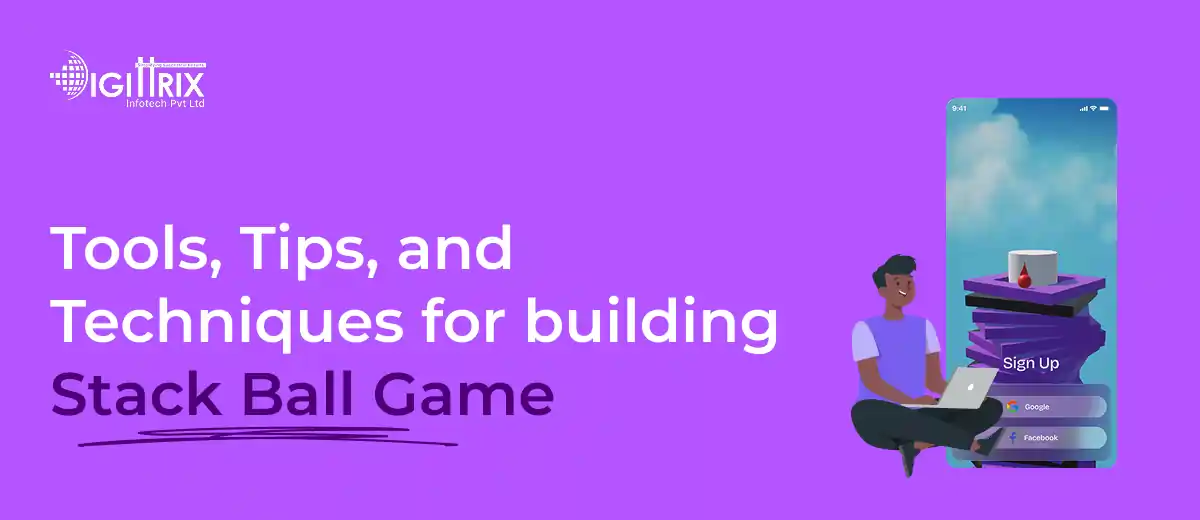Stack Ball-style games lead the hyper-casual gaming scene with millions of downloads, making them perfect for quick, addictive mobile experiences on Android and iOS.
Highlights
An enthusiastic developer and skilled business management expert with over a decade of experience in the field

The world of mobile games has expanded quickly, and hyper-casual games are among the most downloaded and played types. One such game, Stack Ball, became popular because of its simple mechanics and satisfying gameplay. If you've thought about making a similar game, you're not alone. Many developers and enthusiasts are looking into how to create similar interactive games for Android and iOS.
In this article, we’ll take you through a step-by-step guide to creating a Stack Ball-style game from the ground up. Whether you're new to mobile game development or have experience with other types of apps, this guide will help you understand the tools, techniques, and workflow needed to get your game started.
Curious about AI in gaming? Explore top use cases, benefits, and future trends in AI in Game Development.
Before starting development, it's important to know what a Stack Ball game involves. In simple terms, it's a 3D arcade game where a bouncing ball crashes through a series of colourful platforms stacked like a tower. The ball can only break colored parts of the platforms. If it hits black-colored obstacles, the game ends. The goal is to reach the bottom of the stack.
This format is easy to understand and suitable for all age groups, making it ideal for those interested in Stack Ball Game Development. The game is fast-paced and designed to be played in short bursts, which makes it perfect for mobile users.
Planning is one of the most important steps before actual development starts. It helps avoid unnecessary confusion during the process and keeps the project on track. In this stage, focus on a few core aspects:
If you aim to build an app like Stack Ball, these elements should closely match what players expect while also offering some freshness.
Choosing the right game engine is one of the first technical decisions you’ll make. A game engine provides the tools needed to design scenes, add physics, manage audio, and export the final product. For 3D mobile games, two engines stand out.
Unity is widely used across the industry. It is suitable for both small and large projects. Its drag-and-drop features, combined with scripting options, give developers great flexibility. Unity also includes support for realistic physics, which is a major component of Stack Ball gameplay.
Godot is an open-source option and suitable for developers who want more control and a lightweight setup. It is beginner-friendly and runs well on most systems. It supports both 2D and 3D game types and is a good starting point for those experimenting with game app development.
Whichever engine you choose, make sure it supports exporting to mobile platforms like Android and iOS, as mobile game app development is your primary goal.
Alongside the game engine, several tools are useful during development. These help with asset creation, scripting, and testing:
Good preparation using these tools will keep your development smooth and help you complete your Stack Ball clone game faster.
The player taps the screen to make the ball fall and break through platforms. When the finger is lifted, the ball stops. This simple action-and-response setup is part of the game’s charm. Controls should feel responsive and consistent.
The platforms are usually colored and stacked around a rotating central pole. Some segments of the platforms are black. If the ball touches those, the game ends. This creates a challenge for the player and keeps the game exciting.
To keep things interesting, each level should feel different. Change the color patterns, platform arrangements, rotation speed, and even the number of platforms per level. Gradually increase the difficulty so players don’t feel stuck too early or bored later.
These details are essential to delivering a well-rounded experience and should be a priority during Stack Ball Game Development.
In hyper-casual games like Stack Ball, the look and feel should be clean and appealing. Bright colors, fluid animations, and smooth transitions help the game feel polished.
If you’re aiming to build an app like Stack Ball, these visual elements should reflect the style of the original while still being unique to your design.
Sound is just as important as visuals in creating an immersive experience. A well-timed sound effect can make the action feel more rewarding.
Even a simple Stack Ball clone game can feel much more complete when proper sound effects are used. Test your game with and without sound to appreciate the difference it makes.
Once the basic version of your game is built, it’s time to test. This step helps identify problems that could make the game crash, run slowly, or respond poorly.
Test for:
Ask friends or testers to play the game and collect their feedback. Their experience will help you fix small things that you might have missed.
In mobile game development, user experience is often what determines success or failure, so this phase should never be skipped or rushed.
To publish on Android, sign up for a developer account on Google Play. Upload your game’s APK file, provide a description, add screenshots, and set pricing if applicable.
Publishing on iOS involves creating an Apple Developer account. The process includes uploading an IPA file, passing Apple’s review process, and managing app store details.
Whichever platform you choose, you’ll also need a privacy policy, support contact, and app rating. This is an important part of game app development and should be handled carefully.
Publishing the game isn’t the end. People need to know about it. There are many ways to let users know your game exists:
Even a simple Stack Ball clone game can get good traction with the right promotion. Track downloads, reviews, and user engagement after the release.
After launch, continue supporting your game. Fix any bugs that users report, and keep improving performance. You can also release updates with new levels, visual changes, or gameplay additions to keep your audience interested.
Monitor user reviews and respond to their concerns where possible. It builds trust and can lead to better ratings. Long-term success in game app development often depends on how well you maintain and update your product.
Looking for expert Unity game development? Discover why Digittrix excels in Unity game creation with tailored solutions across 2D, 3D, VR/AR, and more.
Building a Stack Ball-style game from scratch is very achievable, even for individuals or small teams. With the right tools and approach, you can build a smooth and fun gaming experience that performs well on mobile devices. The key is to keep the gameplay simple, test thoroughly, and focus on the user experience.
If you're stepping into the world of mobile game development, starting with a game like Stack Ball offers a perfect balance of challenge and opportunity. You get to learn about controls, physics, 3D assets, and mobile publishing all in one project.
To build an app like Stack Ball, think about what made the original fun and try to keep that feeling alive in your version. Small creative changes can help your version stand out while keeping the experience familiar for players.
Whether your goal is personal learning or publishing on app stores, this journey can be both rewarding and enjoyable.
Stack Ball-style games continue to be popular in 2025, offering simple controls, enjoyable gameplay, and high replayability. These games appeal to mobile users because of their quick-paced action and easy-to-understand mechanics, making them perfect for short gaming sessions.
If you're planning to create a game like Stack Ball, working with a trusted mobile game development company makes all the difference. At Digittrix, we provide full support—from planning your idea to publishing the final game. Our team focuses on clean visuals, smooth gameplay, and user-friendly design to build games that feel great to play.
Whether you’re looking to create an app like Stack Ball or develop your own Stack Ball clone with added features, Digittrix can assist. Our developers employ the latest tools and engines to ensure high-quality results for both Android and iOS platforms.
Thinking about starting your Stack Ball game project, or want to know the cost? Contact Digittrix at +91 8727000867 or email us at digittrix@gmail.com for a clear and detailed consultation.

Do you need help in Mobile App development?




Join over 1500+ businesses we've already helped!
Beauty App Development: Tips to Grow Your Business Through an App & Cost in India (2026)
Unity is the most popular choice due to its strong physics support and cross-platform features. Godot is also a good option for lightweight 3D game development.
Yes, some game engines offer visual scripting, but understanding basic programming can help add custom features and better control game mechanics.
It depends on your experience and the game’s complexity. A basic version can take 2–4 weeks, while polished versions with levels and effects may take longer.
You can publish it on Android via Google Play or on iOS through the Apple App Store. Both platforms support hyper-casual mobile games.

©2026Digittrix Infotech Private Limited , All rights reserved.